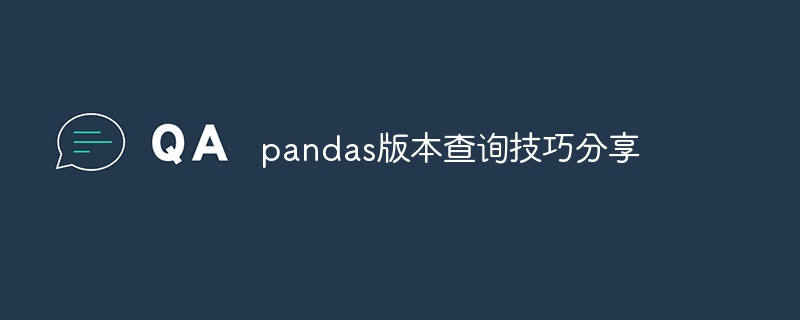Home >Backend Development >Python Tutorial >Explore tips for pandas version query
Explore tips for pandas version query
- PHPzOriginal
- 2024-01-13 15:13:061387browse

Pandas version query skills sharing
Pandas is one of the most popular data analysis and processing libraries in Python. Pandas has been updated and updated over time, with each new version bringing new features and improvements. In practical applications, we often need to query the version number of Pandas and adjust the code according to the version difference. This article will share some techniques for Pandas version query and provide specific code examples.
Method 1: Use code to query the version number
Pandas provides a simple method to query the version number, which can be completed with just one line of code. The following is a code example:
import pandas as pd print(pd.__version__)
Executing the above code will output the Pandas version number on the console. This is the simplest and most commonly used method and works with all versions of Pandas.
Method 2: Check whether the Pandas version meets the requirements
In actual development, we often need to judge whether the Pandas version meets certain requirements in the code, so as to adopt different processing methods. The following is an example:
import pandas as pd
if pd.__version__ >= '1.0.0':
# 执行适用于较新Pandas版本的代码
print("该版本Pandas支持新特性")
else:
# 执行适用于旧版本Pandas的代码
print("该版本Pandas不支持新特性")In the above example, we compare the version numbers to determine whether Pandas supports new features. If the version number is greater than or equal to 1.0.0, execute the code applicable to the newer version, otherwise execute the code applicable to the older version. This method allows the flexibility to choose different processing methods based on version numbers.
Method 3: Adjust parameter settings according to Pandas version
Sometimes, different versions of Pandas will have different parameter settings. In order to ensure the compatibility and correctness of the code, we need to adjust the parameter settings according to the Pandas version.
The following is an example that shows how to adjust the default printing options of DataFrame according to the Pandas version:
import pandas as pd
if pd.__version__ >= '1.0.0':
pd.set_option('display.max_columns', None)
else:
pd.set_option('display.max_columns', 5)
# 打印DataFrame,显示所有的列
print(df)In the above example, we adjust the default printing options of DataFrame by judging the version of Pandas. If the version number is greater than or equal to 1.0.0, all columns are displayed; otherwise, only the first 5 columns are displayed. This can unify the printing effect on different versions of Pandas.
Conclusion
Pandas version query skills are very important for writing code that applies to different versions of Pandas. In actual use, we can query the version number of Pandas through a line of code and make corresponding adjustments based on the version difference. In addition, you can also make conditional judgments based on the version number, choose different processing methods, or adjust parameter settings based on the version. Mastering these skills will help you deal with different versions of Pandas more flexibly and efficiently, improving the efficiency and accuracy of data processing.
The above is the detailed content of Explore tips for pandas version query. For more information, please follow other related articles on the PHP Chinese website!

